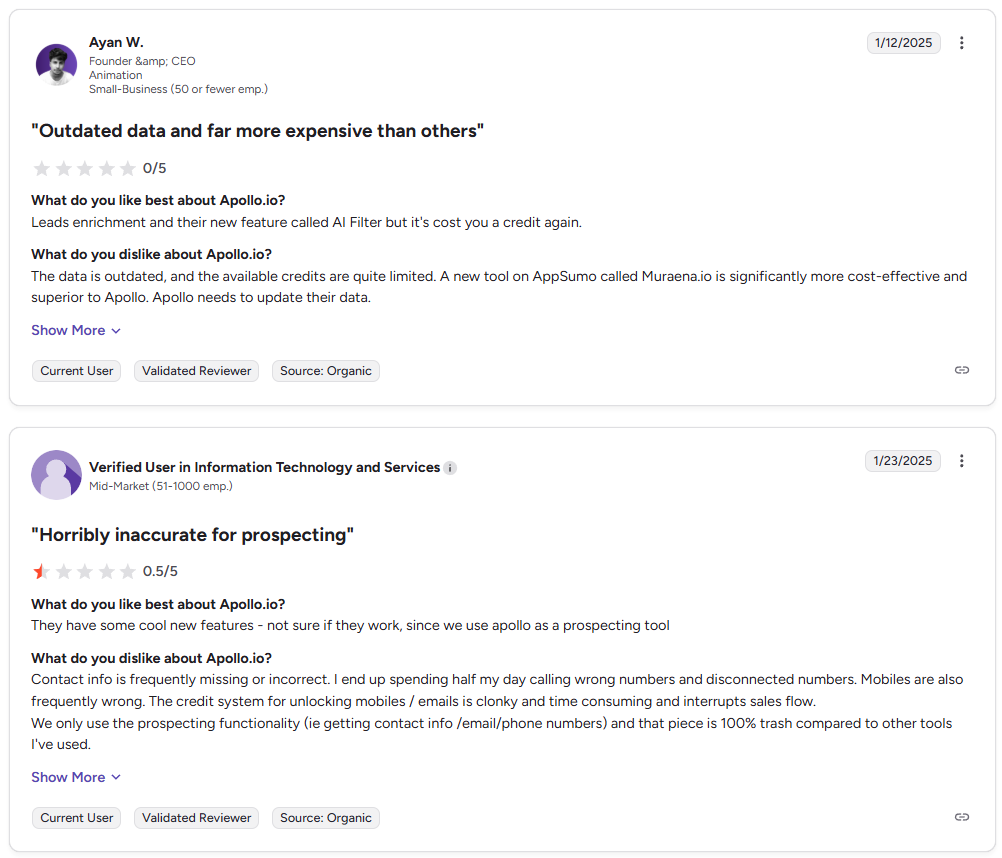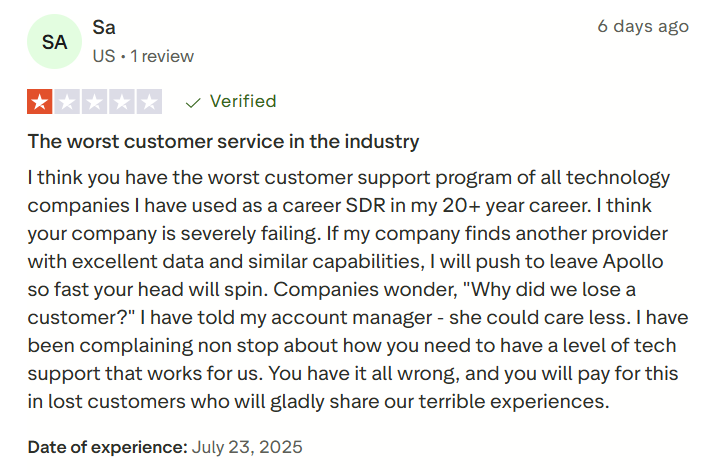Clay vs Apollo vs Leadsforge: Which One Is Best For Finding Leads?



The table above provided a concise summary of the lead generation tools, but for all sales teams to have the deepest understanding of Clay, Apollo and Leadsforge, and to help you optimally streamline your sales processes, let's dive deeper into each tool.
Data Sources
- Clay sources data from 100+ third-party providers covering firmographics, technologies, funding, and more.
- Apollo taps over 210 million contacts and 35 million companies with multiple providers in one place.
- Leadsforge boasts a 500M+ contact database via a unified proprietary source. Its sheer scale often surfaces contacts missing from others.
Data Accuracy
All three ensure high data quality:
- Clay uses vetted sources
- Apollo markets “accurate data, when you need it”, though not all customers feel the same way:

- Leadsforge auto-verifies contacts in real time.
Search & Input Methods
Clay and Apollo rely on search interfaces or workflows:
- Clay users build pipelines (via drag-and-drop or code) to query providers
- Apollo offers manual search filters for job titles, technologies, and firmographics.
With Leadsforge, instead of entering filters or uploading lists, sales reps just describe the ideal customer in natural language. Leadsforge’s AI then instantly compiles matching leads.
AI-Powered Lead Search
Each platform leverages AI differently:
- Clay has AI research agents that can flag domains, summarize job posts or financial docs, and even score leads.
- Apollo provides AI assistants for writing and analyzing emails, drawing on its 270M+ data.
- Leadsforge has pre-built prompts that guide the chat. Users can select recipes (e.g. “Find technical recruiters at growing AI companies”) that immediately return hundreds or thousands of prospects.
Data Enrichment Process
Clay and Apollo use multi-source enrichment, but in opposite styles:
- Clay can perform waterfall enrichment across providers (built-in logic picks which API to call) without per-contact subscription constraints.
- Apollo offers CSV, CRM, or API enrichment to keep existing data fresh - enriching leads in-place and syncing back to your CRM.
Leadsforge blends search and enrichment:
- Once its AI finds leads, it enriches and verifies each record on the fly. There’s no separate upload step - you get already-enriched lists of valid contacts instantly.
Enriched Contact Data
Quality enriched data is essential for personalized outreach:
- Clay’s enrichment can pull firmographics, technographics, and more for each lead.
- Apollo promises “richer prospect profiles with 30+ data points” and keeps your CRM “always fresh & actionable”.
- Leadsforge’s output profiles each lead with available firmographics and validated emails. Crucially, its AI automatically filters out outdated or invalid contacts during compilation, boosting the accuracy of the lead data.
Integration & Workflows
Clay emphasizes workflow flexibility and broad integrations. You can push Clay data to any tool via its HTTP API and built connectors.
Apollo includes native integrations with Salesforce, HubSpot, Marketo, and others, plus an API for custom syncs.
After generating leads with Leadsforge, you export them (CSV or CRM sync) to your chosen outreach tool (especially optimal to sync with other Forge ecosystem products). The ability to export as a CSV make it usable with practically every outreach tool.
Lead Generation Approach
Clay excels at enriching and scoring current prospect lists, as well as triggering workflows to build opportunities.
In Apollo, you can search its database to add contacts, then run sequenced campaigns or import them into your CRM.
Leadsforge is fundamentally a lead creation tool. You start from scratch by defining an ideal profile and get back thousands of fresh leads.
Personalization & Engagement
Effective outreach hinges on personalization:
Clay does not send emails itself, but it connects leads into your email tools.
Apollo’s platform has robust email sequencing and sales engagement features. It auto-personalizes messages using AI.
Leadsforge's focus is creating the list. However, the high-quality, targeted leads Leadsforge delivers make personalized campaigns easier.
Email & Outreach Features
Clay provides AI message drafting and integrates with email tools, but you still manage sequences elsewhere.
Apollo offers an engagement platform with templates, A/B tests, inbox warmup, and automatic follow-ups.
Leadsforge hands off leads to your sales engagement or CRM software. Leadsforge is part of the Forge ecosystem of products (Salesforge, Mailforge, etc.) which cover every aspect of cold outreach.
Unique Tools & Strengths
Clay offers AI formulas for data transforms, custom lead scoring models, and triggers like job-change alerts. It provides data enrichment tools or clean data with conditional logic.
Apollo combines prospecting, enrichment, sequences, CRM, and even conversation intelligence into one platform, though it's worth mentioning its lackluster support:


Leadsforge offers a revolutionary list-building experience:
- Its chat-centric “recipes” remove complexity
- Non-technical users can get thousands of leads with a few chat prompts
- No filters or uploads are needed - just conversation.
And just in case support is necessary, Leadsforge has an active support chat, an extensive knowledge base and more.
Free Plans & Pricing
All three use a credit-based model:
- Clay has a free plan (100 credits/month) and various paid tiers. Clay’s free plan does not include phone lookups. Paid plans start from $134/month if billed annually.
- Apollo’s Starter plan is free with limits and paid plans add more credits per month. Paid plans start from $49/month if billed annually.
- Leadsforge offers a free trial credit bundle (100 free credits) and paid packs (starting from $49/month for 2,000 credits). Leadsforge's credits are spent only for exported leads.
Apollo, Clay and Leadsforge - Which One To Choose?
For sales teams, choosing the right lead generation tool depends on workflow and goals:
- Clay excels in building custom enrichment workflows and consolidating many data providers.
- Apollo is strong as an all-in-one sales intelligence and engagement platform.
- Leadsforge shines if you want instant lead lists with minimal effort - it uniquely combines AI search, an enormous proprietary database, and live verification.
In many comparisons, Leadsforge’s ease of use and coverage give it the edge in raw lead generation - especially for teams prioritizing rapid list building and data enrichment without complex setup. But overall, the tool you go with comes down to what your needs are.
Want to hear more from the Forge?
Frequently asked questions
By enabling users to describe ideal customers in plain English, Leadsforge automates list building and delivers enriched contact data without manual filters.
Apollo offers a limited free tier; Clay provides a free plan too; Leadsforge grants free credits upon sign-up.
All three offer CRM integration, but Apollo is best for API access and extensive integrations, Clay offers moderate options but thorough nonetheless, and Leadsforge’s Forge ecosystem ensures smooth syncing along with integration capabilities with other third party tools (or just exporting lead lists as CSVs).